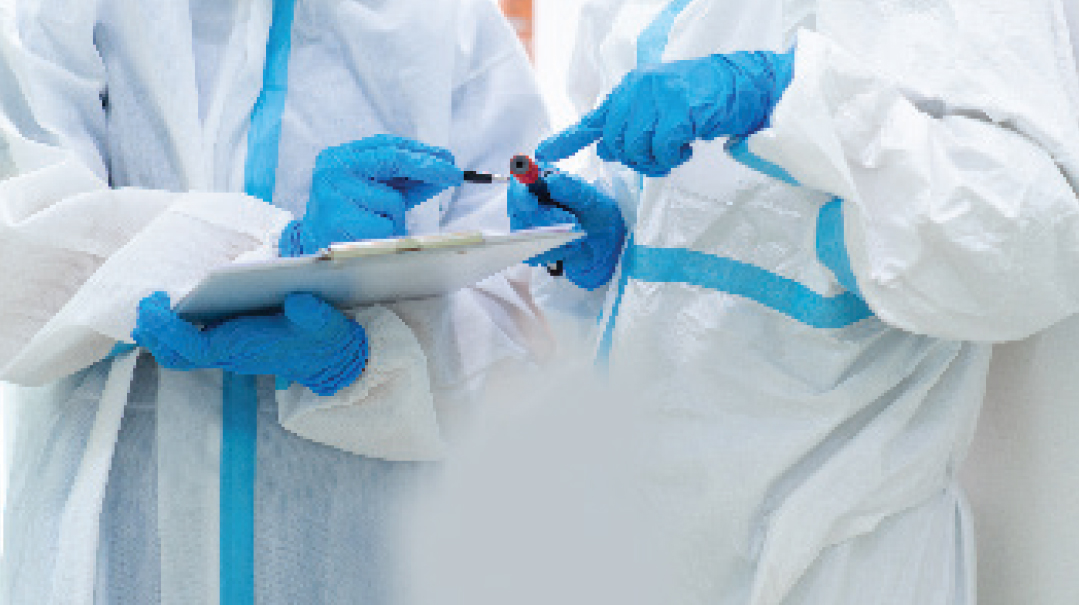Covid Clarity: Just the Facts
| December 23, 2020A team of medical experts takes your questions about the pandemic and sets things straight

Yosef Levenbrown, DO, is a Pediatric Critical Care physician at AI duPont Hospital for Children and medical advisor to the COVID Plasma Initiative since its inception.
Chava Ruderman, MD, MPH, is an internist with training in epidemiology and biostatistics and currently works at a startup company developing a clinical decision support tool for physicians. She is a medical advisor to the COVID Plasma Initiative.
Aliza Rubenstein holds a PhD in quantitative biomedicine and is currently researching diagnosis of COVID-19 and COVID-19 vaccines. She has been involved in the COVID Plasma Initiative since its inception.
Why are we still concerned about COVID-19? In the frum community at least, it seems the situation is nowhere near as dire as it was last March and April.
Baruch Hashem, there have been a number of positive developments with regard to COVID-19 since the first wave hit the Western world ten months ago. Thanks to the immense amount of scientific research that has been done, we know much more about COVID-19, including how to better identify people at higher risk for becoming severely ill from COVID-19, so that we can implement safety measures to minimize their exposure.
Since March, medical staff have acquired much more experience treating COVID-19 and have more therapeutic options available to offer to patients. Perhaps most exciting is the earlier-than-anticipated approval of a safe and highly effective vaccine against the virus, now in the first phase of release.
Since much of the current success in treating COVID-19 is due to better hospital care, this advantage could disappear as hospitals become more crowded and staffing shortages occur. Unfortunately, the number of new infections, new hospitalizations, and new deaths by day have been rising rapidly for the past few months.
As of this writing, the deadliest day of the COVID-19 pandemic in the United States was December 16, when 3,611 deaths from COVID-19 were reported. In the frum Tristate area, although we had a lull in cases between Succos and November, the number of new infections and new hospitalizations in our communities is now rising as well. There have been at least 16 COVID-19 deaths in Lakewood since September, and there are still frum individuals dying weekly.
The one constant of the COVID-19 pandemic seems to be the perceived fluctuations of medical guidance directed at the layperson. Has anything changed in what we know about COVID-19 preventive measures (e.g., masks, distancing, etc.)?
This is unfortunately the inevitable state of research when studying a new disease: constant updates based on new data. However, the consensus of the medical community regarding best preventive practice has remained generally consistent since April, supporting the use of masks when in public and social distancing as the two best currently available means of reducing COVID-19 transmission.
We now know that while transmission of COVID-19 may be primarily via droplet transmission between two people in close proximity, there is some evidence of airborne transmission (i.e., COVID-19 transmission over longer distances, and possibly lingering in the air). This is exacerbated when people shout or sing in a place with poor ventilation. Since the winter weather is forcing all but the hardiest indoors, increasing ventilation by opening windows and/or retooling HVAC systems can potentially decrease COVID-19 transmission.
Finally, and perhaps most importantly, testing people for COVID-19 when they are symptomatic and following CDC quarantine/isolation guidelines for individuals who have been exposed or infected continue to be crucial components of reducing the spread. It is also vital to protect the vulnerable and ensure that elderly people are not exposed to people who may transmit the disease to them, even friends and relatives.
How important is it that my family comply with social distancing if we’re young? At this point, who is considered to be at risk from COVID-19?
By analyzing the data on the hundreds of thousands who have become severely ill or died from COVID-19, researchers can now predict who is the most susceptible to this disease. While those who are elderly are the most well-known at-risk group, there are other less well-publicized conditions that place people at risk.
Based on the most current evidence, the CDC has identified a range of conditions that increase, or may increase, a person’s risk for developing severe illness from COVID-19. Some of the conditions that increase risk include: pregnancy, obesity (BMI > 30), smoking, cancer, chronic kidney disease, COPD, heart conditions, type 2 diabetes, and an immunocompromised state from solid organ transplant.
Among the conditions that may be associated with risk for severe COVID-19 are: a history of strokes, high blood pressure, overweight (BMI greater than 25 but less than 30), type 1 diabetes, liver disease, dementia, moderate-to-severe asthma, and having a weakened immune system (for example, due to blood/bone marrow transplant, HIV, or use of corticosteroids or other immune suppressant medicines.
If someone gets COVID-19, are there any treatments for them to pursue at home?
COVID-19, as with many viral diseases, can have at least two distinct phases. In the first phase (generally five to seven days), the virus multiplies in the body and the body’s immune system mobilizes to combat it. In some individuals (often those at high risk), the immune system can become hyperactivated, triggering a second phase in which the body releases a large number of substances (such as cytokines) that cause inflammation, which may be effective in killing the virus, but can also harm the body in the process. This hyperinflammatory phase is the point when the virus can become deadly, as the lungs, heart, or kidneys can fail, and is usually the reason why hospitalization becomes necessary.
By helping the immune system quickly conquer the virus or by shortening the first phase, we can potentially make it less likely that an immune overreaction will occur, thereby reducing the possibility of hospitalization and death.
There are several therapeutics that can possibly boost the effectiveness of the immune system’s response to COVID-19. One of the newest therapies is monoclonal antibodies, a treatment that supplies virus-fighting antibodies to your blood in a more concentrated form than convalescent plasma does. This approximately one-hour infusion takes place in hospitals (and sometimes in nursing homes) on an outpatient basis. Because the point of monoclonal antibodies is to shorten the first phase of the disease and possibly decrease the need for hospitalizations, it is likely to be more effective if given earlier. In fact, the treatment is typically only available to patients who have not yet developed severe COVID-19 symptoms, such as a need for supplemental oxygen, and may not be offered to those who are further along in their illness. Because there are limited doses of this innovative treatment available, its use is also restricted to COVID-19 patients who have at least one risk factor. If you or your loved one contracts COVID-19, it is important to consult your doctor immediately to discuss if this therapy is appropriate. Additionally, there are some studies that show that patients with low vitamin D levels may have worse outcomes, so your physician may recommend that you take vitamin D.
At what point should someone with COVID-19 seek hospitalization?
Anyone experiencing difficulty breathing should call 911 (or Hatzalah) or go to the emergency room immediately. COVID-19 can also cause many non-respiratory symptoms. Difficulty breathing, chest pain, severe gastrointestinal symptoms, or fainting are examples of additional reasons to go to the emergency room.
It’s important for people with COVID-19 to monitor their oxygen levels regularly, including while walking around. One factor that increases potential danger is that COVID-19 can cause “silent hypoxia,” in which the patient does not feel breathless and does not realize that their oxygen level is dropping. A pulse oximeter is a simple-to-use tool that is placed on the finger to determine the current levels of oxygen in the blood. Pulse oximeters can often be obtained from Hatzalah, bikur cholim, a pharmacy, or purchased online.
The New York City Department of Health has offered guidance to the public regarding monitoring pulse oximetry levels at home. They advise that, generally speaking, individuals with oxygen levels below 90% should call 911 (or Hatzalah) or go to the emergency room immediately. Those with oxygen levels in the range of 91% to 94% should immediately do one of the following: contact their own health care provider, obtain an urgent care evaluation at no cost by calling 332-220-1337 (or going to www.ExpressCare.nyc), or go to a nearby urgent care facility. Hospitalization may be recommended. An oxygen level of 95% or above is normal, and individuals in this range should continue to monitor intermittently by walking around for two minutes to see if it falls below 95%; if so, follow the instructions above.
Hospitalized patients with an oxygen level below 95% may be treated with supplemental oxygen, as well as additional therapies that are only available in the hospital, including convalescent plasma, remdesivir, or a steroid such as dexamethasone. These treatments are often less effective later in the course of the illness, so they may not be medically appropriate for patients who are further along in their illness.
(Originally featured in Mishpacha, Issue 841)
Oops! We could not locate your form.












